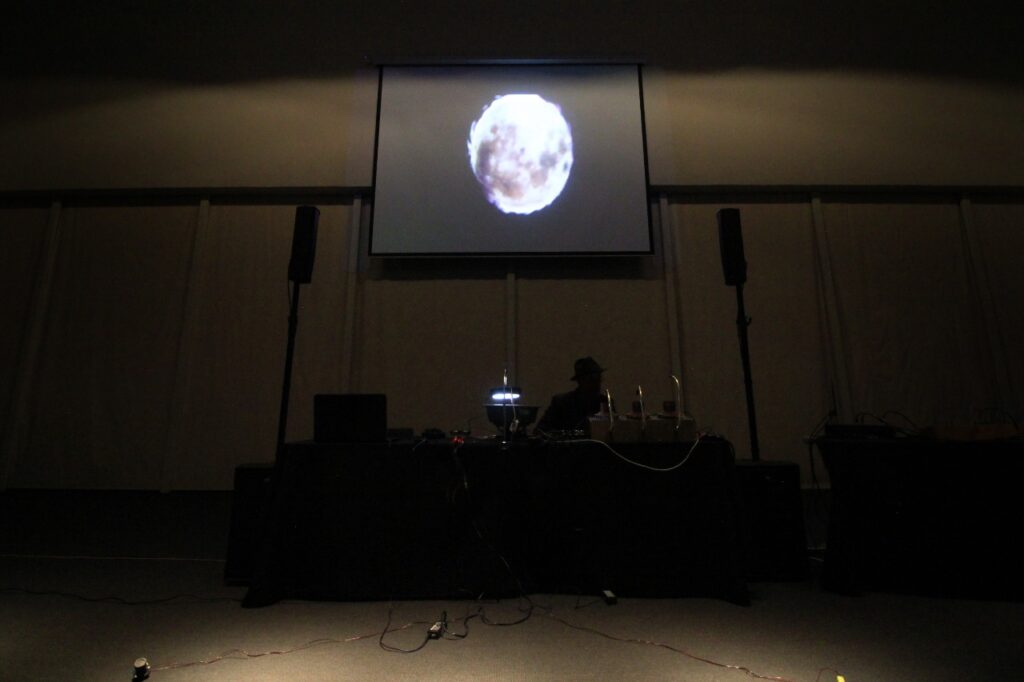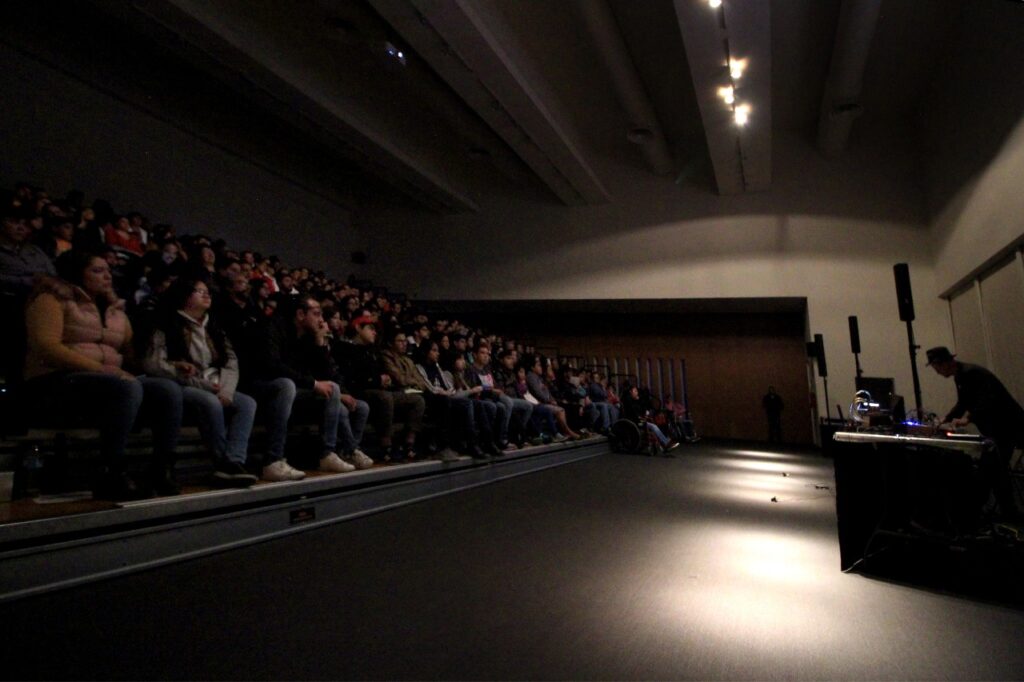
Alunizar is a visual and sound installation that explores the delicate relationship between the Moon and water on Earth. The cymatic artifact consists of a black basin filled with water, on top of which is a circular light box with a luminous image of the full Moon. In the center of the image, there is a small perforation that houses a high-resolution mini camera that films the reflection of the Moon on the water. This image is then projected onto a screen. Underneath the basin is a sound transducer, a Raspberry Pi microcomputer that processes sound frequencies. These frequencies are transmitted to the transducer, which propagates sound waves into the water.
By using the elastic properties of water and cymatic experiments, one can observe how water responds to the physical force of sound. The image of the full Moon reflected in the water when receiving sound frequencies begins to vibrate and distort, changing its shape in an audio-rhythmic way. The combination of diffraction and refraction leads the real image to transform into an abstraction of aesthetic patterns produced by the sound process. The camera that films these processes is projected by a computer vision system, resulting in a combination of natural, electromagnetic, and digital processes.
Cymatics is a branch of acoustics that studies the visible patterns produced in non-rigid media, such as liquids and gases, when exposed to sound waves. In the case of cymatics with water, it is a technique that uses water to demonstrate the physical effects of sound waves in a non-rigid medium. Sound waves cause the surface of the water to vibrate and create patterns and shapes in the water that can be observed with the naked eye. These patterns can be very complex and beautiful, and their appearance depends on the frequency and amplitude of the sound waves used.
The Moon and water on Earth maintain a close relationship that has been observed and studied since ancient times. From a scientific perspective, it has been shown that lunar gravity exerts a strong influence on tides, causing the alternating rise and fall of sea levels. Additionally, some studies suggest that the gravitational influence of the Moon also affects cloud formation and the circulation of Earth’s atmosphere, which could impact global weather conditions. It has even been proposed that the Moon could influence the movements of the Earth’s crust, which could have an effect on seismic and volcanic activity.
But the relationship between the Moon and water on Earth is not just scientific. Indigenous peoples from different parts of the world have also observed and understood this connection for ages. For example, the Maya of Mesoamerica believed that the Moon was a divine being that influenced the cycles of life and death. It is also said that pre-Columbian peoples of the Andean region in South America had a deep knowledge of the Moon’s influence on agriculture and fishing.
In the Aymara culture of the Andes, it is believed that the Moon is the mother of water and that without it, there would be no rain or life on Earth. According to this belief, the Moon and water have a spiritual and ancestral connection that is reflected in the way that rain and moisture are distributed across the landscape.
From both a scientific and spiritual perspective, the relationship between the Moon and water on Earth is fascinating and complex.
Viktor Schauberger was an Austrian scientist and philosopher who devoted much of his life to the study of nature and its processes. One of Schauberger’s main theories focused on the use of vortices in nature as a means of generating energy and purifying water.
Schauberger believed that vortices were a fundamental force in nature and were responsible for the creation and maintenance of life. He also believed that vortices could be used to create clean and sustainable energy flows, rather than relying on fossil fuels.
Regarding the moon, Schauberger observed that lunar gravity affects the movements of water and other fluids on Earth, creating complex vortex and flow patterns. He believed that by understanding these flow patterns, it would be possible to design more efficient and environmentally friendly transportation systems.
In particular, Schauberger investigated how the potential energy derived from the gravitational movement of the full moon could be used to transport tree trunks through rivers. He observed that during the full moon, lunar gravity produces high tides that raise the water level, which in turn generates vortices that can be used to propel the logs. This technique, known as lunar flotation, is used in some parts of the world to transport wood sustainably.
Schauberger was a visionary and pioneer in his field. His theories about the power of vortices and the importance of working with nature rather than against it were innovative for his time and still have relevance today.
KOSMIKA. Imaginaries on the Moon.
The first prototype was presented as a live performance at the auditorium of the “Laberinto” Museum of Science and Arts for the Kosmika festival.




CORDELIA



